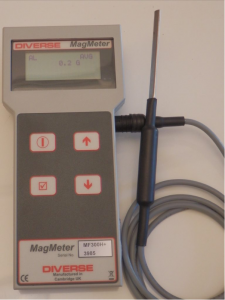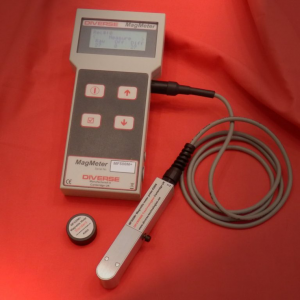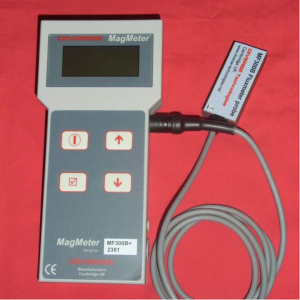FERRITE METER MF300Fm+

The Diverse Ferrite meter MF300Fm+ measures the Ferrite number (FN) of austenitic and duplex stainless steel weld material. There are 4 probe options: P46 with an active area of 4x6mm; P46R right angled probe; P10 that is sensitive to ferrite content in a 10 mm diameter; P10AC is an air cooled version of P10 for use with hot samples. Depth sensitivity of approximately 1 mm.
MF300Fm+ can be supplied with up to 5 probes as follows: P10 (1 or 2), P46, P46R and P10AC. The instrument is calibrated using NIST secondary weld standards. All 16 standards are used in the calibration giving an instrument with a measurement range from 0 to 115 FN. Transfer standards are supplied with the instrument allowing performance to be verified at any time.
MAGMETER MF300H+ Magnetic Field Meter

The Diverse MF300H+ is a hand held, battery operated Magnetic Field Meter with a rugged stainless steel Hall effect probe suitable for both laboratory and workshop use. The meter is microprocessor controlled and uses a membrane key pad and a digital display which makes it simple to operate but at the same time offers the ability to do complex measurements.
Measurements of magnetic fields together with the selected units and a linear progress bar scale are displayed on the instrument. Operating modes are average, absolute peak, bipolar peak and true RMS. There is a built-in data logger that can collect 100 samples in the chosen measurement mode and at a selectable rate. The results can be viewed on screen or optionally downloaded via the serial RS232/USB interface. Software for use with the meter is provided with the serial option which enables data to be saved and entered in spreadsheets.
MAGNETITE METER MF500M+

Measurement of magnetite in stainless steel pipes
Stainless steel superheater and reheater tubes, operating with high temperature steam for extended periods, develop a two-part oxide layer on the inner bore of the tubes. The magnetite oxide is characterised by two distinct phases which have different coefficients of expansion. The layer closest to the tube centre is iron rich, and the layer close to the tube wall is chrome rich. At metal temperatures of 90C to 150C, the outer layer of magnetite oxide tends to delaminate from the tightly adhering inner layer and parent metal.
Delamination of this outer layer and a small amount of inner layer causes magnetite to fall under gravity and block the bottom of vertical or pendant superheaters. If total blockage occurs in a tube, the steam flow paths, being established in a boiler as it builds steam pressure, bypass this blocked tube. Without the cooling steam, this causes overheating of the blocked tube leg which results in failure of the tube.
The Software embedded in the MF500M provides acquisition of the magnetic force extended by the magnetic effect of the magnetite. The force is a measure of the amount of magnetite and its range. This information is used together with the geometry of the pipe (assumed linear with defined diameter and wall thickness) to gauge the amount of occlusion. The force effect is dependent on how the magnetite appears in the pipe. It may be deposited in a similar way to calcite, or appear as broken magnetite. The density reduction of broken magnetite is built into the instrument, so that the degree of occlusion can be inferred for each scenario.
FLUXMETER MF300B+

The Diverse MF300B+ hand held, battery operated Magnetic Flux Meter with its rugged stainless steel probe is suitable for laboratory and workshop use. The meter is microprocessor controlled and uses a membrane key pad and a digital display which makes it simple to operate. The MF300B+, is a novel search coil based instrument that steals flux from the ferrous material under test (MUT) to assess the level of magnetic flux inside the MUT. By integrating the change in magnetic flux lines between a position in air and on the surface of the MUT the flux in the material can be estimated. There are a wide range of applications for the instrument but it has found important use in NDT, allowing material magnetization to be assessed for magnetic particle inspection (MPI).
